










WaterFurnace geothermal systems provide reliable operation 24 hours a day, 7 days a week, 365 days a year—rain or shine, day or night, windy or not. They use the stored solar energy in the ground to provide your family luxurious comfort and incredible savings. In fact, it’s the only HVAC system that’ll pay you back. To learn more, contact your local WaterFurnace dealer today.
visit us at waterfurnace.com/Reliable


Your Local WaterFurnace Dealers
Arcadia/Mondovi Water Source Htg & Clg (715) 833-9001
Beaver Dam/Green Lake Air Care, Inc. (920) 356-8860

Black River Falls/ Stevens Point Northern Indoor Comfort (715) 937-2676
Cashton/Sparta Flock’s Htg & A/C (608) 269-1500
Chaseburg/Coon Valley Flock’s Htg & A/C (608) 269-1500
Clintonville/Oshkosh Van’s Refrigeration (920) 833-2051
Cornell/New Auburn Water Source Htg & Clg (715) 833-9001
Dodgeville/Baraboo Modern Htg & Clg (608) 767-2689
Eau Claire/Osseo Water Source Htg & Clg (715) 833-9001
Ellsworth/Lake City Comfort By Design (715) 273-3658

Escanaba/Iron Mountain GPS Htg & Clg (715) 732-2111
Friendship/Waupon All Phase Geothermal (920) 763-2301
Green Bay/Onedia Van’s Refrigeration (920) 833-2051
Hudson/Stillwater Comfort By Design (715) 273-3658
Janesville/Fort Atkinson Don Martin Htg (608) 758-9882
Madison Black Earth Modern Htg & Clg (608) 767-2689
Marinette/Peshtigo GPS Htg & Clg (715) 732-2111
Menomonie/Bloomer Water Source Htg & Clg (715) 833-9001
Neillsville/Medford Northern Indoor Comfort (715) 937-2676
New Lisbon/Shamrock


Deans Refrig. & Heating (608) 372-6928
Oconto/Rhinelander Van’s Refridgeration (920) 833-2051
Osceola/St. Croix Falls Comfort By Design (715) 273-3658
Plymouth/Fond du Lac Advanced Custom Geothermal (920) 894-3999
Prescott/Hastings Comfort By Design (715) 273-3658

Richland Center/Viroqua Strang’s Htg Electric Plmb (608) 647-2855
Siren/Superior Earth Energy Systems (715) 566-0735
Spring Valley/Amery
Comfort By Design (715) 273-3658
Sturgeon Bay/Denmark Van’s Refrigeration (920) 833-2051
Tomah/Oakdale Dean’s Refrig. & Heating (608) 372-6928
Wasau/Angtigo Van’s Refrigeration (920) 833-2051
Westby/La Crosse Flock’s Htg & A/C (608) 654-5522
Wisconsin Rapids/Warens Northern Indoor Comfort (715) 937-2676

The Wisconsin Energy Cooperative News (Formerly Wisconsin R.E.C. News) has been published monthly and distributed since July 1940 to members of Wisconsin’s non-pro t, consumer-owned rural electric cooperatives. It is available to non-mem bers for $13 per year or $35 for three years. Members pay $6.93 per year.
Published by the Wisconsin Electric Cooperative Association, 222 W. Washington Ave., Ste. 680, Madison, WI 53703. Steve Freese, president & CEO.
number: 688-480.
Postmaster: please send address changes to Wisconsin Energy Cooperative News, 222 W. Washington Ave., Ste. 680, Madison, WI 53703.

Periodicals postage paid at Sun Prairie, Wis. Send correspondence to Wisconsin Energy Cooperative News, 222 W. Washington Ave., Ste. 680, Madison, WI 53703. Phone (608) 467-4650.
Web site: www.wecnmagazine.com.
Co-op Members: Please send address changes to your local electric co-op. Contact information can be found on page 18.
Steve Freese WECA president & CEO
Dana Kelroy editor
Mary Erickson associate editor
Julie Lund contributing writer
Ann Bailey graphic designer
Geri Miller advertising consultant
Jennifer Taylor editorial assistant
For advertising opportunities please email geri@weca.coop. The appearance of advertising or events does not constitute an endorsement of the products or services advertised. We reserve the right to refuse advertisers.
recycle
On the cover:
Matt Brandrup, RESCO president and CEO, believes supply-chain issues will continue well into 2023, but the cooperative business model o ers hope.
More on page 12.
cost-e ective
home
rst approach illustrates
cooperative way through supplychain crisis.
for art at Chippewa Valley exhibit.


co-op kids get cozy
their critters.




Winning our September kitchen kit is Oakdale Electric Cooperative member Richard Raith. He entered his submission in the form of a poem.
Back to school, back to school! Don’t make a fuss, just get on the new electric magic bus.
Being a teacher, I know it well and receiving my electrical power services from Oakdale Electric sure is swell.
The magic electrical bus is located on page 4 next to the WECA state of Wisconsin symbol.
This month we challenge readers to nd this paint brush in honor of the artists featured on page 24. Remember that the symbol can be anywhere and any size. One randomly selected winner will receive a Wisconsin Energy Cooperative News kitchen kit. One entry per household, please. Send entries by October 14.

Enter via the “Symbol Search” link on the homepage of wecnmagazine.com.
You can also enter by mail (don’t forget to include the name of your cooperative):


WECA 222 W. Washington Ave., Suite 680, Madison, WI 53703
the heart of the cooperative business model is a “roll up your sleeves and get it done” attitude. Wisconsin’s electric cooperatives epitomize that mindset.
In the 1930s and ‘40s, electricity owed into the state’s more populated areas. Still, most of rural Wisconsin remained in the dark. Forpro t investor-owned utilities knew they wouldn’t make money selling electricity to the far reaches of the state, so they refused to serve those areas.
So with that “roll up your sleeves” attitude, Wisconsin’s rural electric cooperatives were formed to ll the need. Then, when those cooperative businesses saw the need for engineering, public relations, government relations, and uni ed communications, what did they do? You guessed it—they banded together and got it done. Speci cally, they formed the Wisconsin Rural Electric Cooperative Association (WRECA) to meet those needs.
The story of RESCO on page 12 is one of many o -shoots of that original statewide organization. WRECA started not only the rural electric supply cooperative but, in conjunction with statewide organizations in Kentucky and Arkansas, was also the parent organization of the Electric Research and Manufacturing Cooperative, now know as ERMCO. That original statewide organization is now WECA, the publisher of this magazine.
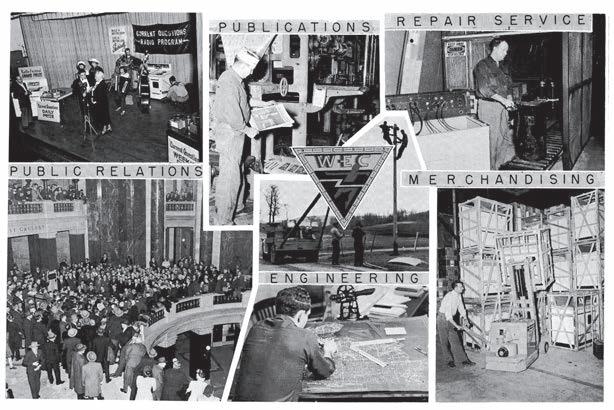
WECA, RESCO, and ERMCO are now separate entities, but all still operate in the best interest of their member cooperatives. And though today’s supply-chain challenges look di erent than those faced in the 1930s, we still roll up our sleeves and get the job done for our members.
Dana Kelroy Editor






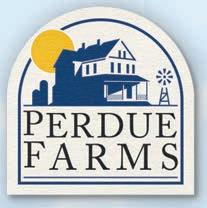












































































According to the National Energy Assistance Directors Association (NEADA), the cost of cooling for the average family increased from $450 to $600 this past summer. NEADA predicts the average family will pay $1,202 to heat their homes this winter, an increase of 17% from last year. Those who heat with natural gas can expect a 34% increase.
According to the Energy Informa tion Administration’s latest short-term energy outlook, the residential price of electricity is up 7.5% from 2021 due to higher natural gas prices.
A recent Gallup poll found 56% of Americans now say inflation is a severe or moderate financial hardship.
Representative Tom Tiffany (R-7th District) and the grid operator that serves Wisconsin, the Midcontinent Independent System Operator (MISO), are urging federal approval of the Nemadji Trail Energy Center (NTEC), a $700 million combined-cycle natural gas plant in Superior proposed by Dairyland Power Cooperative, Minnesota Power, and Basin Electric Power Cooperative.
The 625-megawatt plant would be able to ramp up quickly to backfill for intermittent resources such as wind and solar. The Environmental Protection Agency (EPA) recently ruled the project plan did not address “climate damage,” even though it has undergone extensive environmental reviews and has been approved by regulatory agencies in Wisconsin and Minnesota.
“At a time when our state is at risk of rolling blackouts for the first time ever, it is mind-boggling that a federal agency would take steps to delay Wisconsinites’ access to clean, reli
able, and affordable energy,” Tiffany wrote in a letter to the EPA.
In July, MISO sent a letter to federal officials that reads “…MISO has experienced an increasing number of hours during the year when supply is barely adequate to cover demand even during non-peak season and times of the day.” MISO cited an increase in intermittent resources such as wind and solar.
NTEC is projected to come on-line in 2025, pending final approvals.
More than two dozen environmental and public health groups are pushing the EPA to use its power under the Clean Air Act to ban residential and business fuel and gas-burning appliances.
The groups petitioned the EPA asking it to phase in performance standards for furnaces and water heaters, requiring zero-emissions by 2030. The group is also asking the EPA to formally list all fossil fuel-fired heating appliances, including stoves and clothes dryers, as a new source category of air pollution.
A Solar Energy Regional Test Center is now open in the Upper Peninsula of Michigan. The U.S. Department of Energy, Michigan Technological University, and Sandia National Laboratories are researching how effective new solar technology is in severe winter environments.
At the U.P. facility researchers are testing new methods of rapid snow removal from the solar panels, looking at different materials and configura tions to better understand under what conditions, temperatures, and snow loads the solar panels will self shed, which saves time and money.
President Joe Biden last month signed the Inflation Reduction Act, which includes major investments in clean energy. A key provision in the bill includes direct pay tax incentives, which allow electric cooperatives access to energy innovation tax credits for deployment of new energy technologies including nuclear, carbon capture, storage, and wind and solar expansion.
The bill also includes a $9.7 billion electric cooperative grant and loan program for purchasing or building new clean energy systems and hun dreds of billions of dollars in subsidies for renewable energy projects. It also includes tax credits to help homeowners upgrade their homes with more energy-efficient products and offers a $7,500 tax credit for purchasing electric vehicles, with conditions.
A report by the First Street Foundation, a non-profit risk mitigation research group, finds that a swath of the coun try stretching from Texas to southern Wisconsin could be part of an “extreme heat belt” by 2053, which means the area will experience at least one day per year that feels like 125 degrees Fahrenheit, or warmer. Many rural western Wisconsin counties will also see the greatest difference in heat gains, according to the report.
The report reads, “While all areas of Wisconsin will continue to see increases over the next 30 years, Grant County will face the largest increase in their Local Hot Days between now and 2053. This year, Grant County can expect a week at or above 100.4°F which will grow to 15 days 30 years from now.”
After Grant, the report says the greatest increase in local heat days will occur in Crawford, Lafayette, La Crosse, Green, Vernon, Pepin, Buffalo, Taylor, and Rusk counties.
If you find computers frustrating and confusing, you are not alone. When the Personal Computer was introduced, it was simple. It has now become a complex Business Computer with thousands of programs for Accounting, Engineering, Databases etc. This makes the computer complex.

You want something easy, enjoyable, ready to go out of the box with just the programs you need. That’s why we created the Telikin One Touch computer.
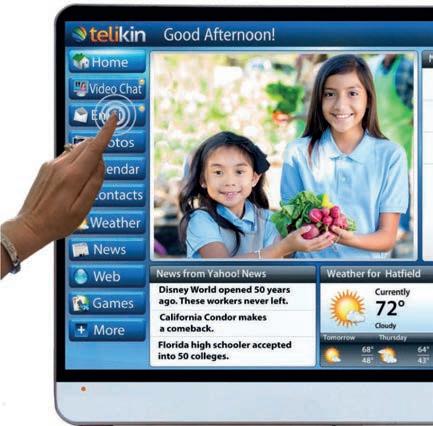
Telikin is easy, just take it out of the box, plug it in and connect to the internet. Telikin will let you easily stay connected with friends and family, shop online, find the best prices on everything, get home delivery, have doctor visits, video chat with the grandkids, share pictures, find old friends and more. Telikin One Touch is completely different.
One Touch Interface – A single touch takes you to Email, Web, Video Chat, Contacts, Photos, Games and more.

Large Fonts, 200% Zoom – Easy to see, easy to read.



Secure System – No one has ever downloaded a virus on Telikin.

Voice Recognition No one likes to type. Telikin has Speech to Text. You talk, it types.
Preloaded Software All programs are pre loaded and set up. Nothing to download.
100% US based support – Talk to a real person who wants to help Telikin has great ratings on BBB and Google!



This computer is not designed for business. It is designed for you!
"This was a great investment." Ryan M, CopperCanyon, TX
"Thank you again for making a computer for seniors" Megan M, Hilliard, OH
"Telikin support is truly amazing ” NickV, CentralPoint, OR

Call toll freeto find out more!

Mention Code 1140 for introductory pricing
Day money back guarantee
This month’s “Message from the CEO” is guest commentary from Rob Richard, WECA director of government a airs. WECA President and CEO Steve Freese is currently on medical leave.
Rob Richard WECA Director of Government A airs
Thenumbers are staggering. Four COVID relief bills passed by Congress and signed into law since the outbreak of the pandemic gave American citizens, businesses, and many of our state and local government institutions financial relief to the tune of roughly $4 trillion. On top of that, we have seen three major spending bills pass Congress in the last 18 months that include roughly $3.85 trillion in additional spending. Keeping track of it all is tricky, but it is clear that some big opportunities exist for electric cooperatives as we move forward in the coming years.
In March of last year, the $1.9 trillion American Rescue Plan Act (ARPA) was signed into law, opening the door for $350 billion in emergency funding for state, local, and tribal governments to respond to the pandemic and its negative economic impacts. Not all of the $4.8 billion that Wisconsin was allocated has been spent yet, but just under $100 million supplemented the Broadband Expansion Grant Program this year, including local cooperatives winning numerous grants to bring fiber to rural businesses and homes. Millions have also gone to renters and homeowners in financial assistance to help with utility and other outstanding bills.
The passage of the $1.2 trillion Infrastructure Investment and Jobs Act (IIJA) in November 2021 set in motion several programs and funding initiatives that have begun to see implementation and will continue over the next five years. Interchangeably called the Bipartisan Infrastructure Law (BIL), the IIJA made significant investments in five major areas where cooperatives can be impacted: clean energy, broadband, grid modernization and resilience, cyber security, and electric vehicles. Our national association has identified 27 different funding opportunities for which electric cooperatives can apply, primarily through competitive grants or funding opportunity announcements (FOAS).
The IIJA picked up where the ARPA left off when it comes to broadband funding. A total of $65 billion will be
allocated to states for broadband deployment and afford ability. The Broadband Equity, Access, and Deployment (BEAD) program is the single largest federal investment in broadband at $42.45 billion, with Wisconsin expected to receive between $700 million to $1.2 billion beginning in the fall of 2023.
Another major initiative in the IIJA includes $7.5 billion for states to partner with private entities, including our local electric cooperatives, on electric vehicle (and alternative fuel) charging infrastructure. The National Electric Vehicle Infrastructure (NEVI) Program lays the groundwork for formula funding designation and use with Wisconsin slated to receive $78.5 million in the next five years. This coincides with five Midwest governors from Michigan, Illinois, Indiana, Minnesota, and Wisconsin an nouncing a collaboration in 2021 to create an EV charging network across the Midwest, followed up by the creation of a Lake Michigan Electric Vehicle Circuit to acceler ate EV adoption policies and practices around the entire 1,100-mile stretch of the Lake Michigan shoreline.
Finally, the $750 billion Inflation Reduction Act (IRA) signed in August is a partisan spending bill on major health care, climate, and tax issues. There are two signifi cant provisions in the IRA on which electric cooperatives will be able to directly capitalize. First, we can now take advantage of direct federal payments (i.e., investment tax credit and production tax credit) to co-ops when new energy technologies are deployed, such as carbon capture, energy storage, nuclear, and renewables like wind and solar. This new measure negates any need for co-ops to rely on for-profit, third-party partners to capture the tax credits. Administered by the USDA, the IRA also creates a nearly $10 billion grant and loan program designed specifically for co-ops that buy or build new clean energy systems. There is an expectation that these two provisions alone will stimulate significant innovation in the coopera tive space, leading to greater consumer-member access to clean, affordable, and reliable power.
With hundreds of billions of dollars expected to fund programs over the next decade in broadband expansion, grid resiliency, cyber security, electric vehicles, direct pay incentives, and clean energy innovation, it is our hope that rural Wisconsin will begin to see parity with urban and suburban population centers when it comes to economic, social, and cultural opportunity in the state. Wisconsin’s electric cooperatives and our consumer members deserve no less.
Acclaimed wildlife artist Greg Alexander's artwork captures a tranquil moment on an autumn morning
The ying pheasants, log, and woodland plants are sculpted in Crelief to add rich dimensionality to the art
The full-color artwork is raised above the handsome wooden plaque for a sophisticated presentation


Each masterpiece features the acclaimed nature artwork of Greg Alexander, ¾-relief sculpture, and a richly dimentional presentation Beginning with “Gather,” each edition can be yours for just three payments of $23.33*, totaling $69.99, (plus $11.99* shipping and service per edition). You will be billed with shipment. Risk-Free Subscription Plan. This is the convenient, risk free auto-renewal plan. You will be charged with each future shipment, about once a month, at the same low price stated above. This continues until you cancel or the collection is complete. You are under no obligation and may cancel at any time. You may also return any item free of charge for a full refund. You need send no money now. Return your Reservation Application today.
Greg Alexander by arrangement
inches by the R-value per inch for the type of insulation.
A: It isn’t pretty, but insulation and air sealing typically provide the biggest bang for your buck when it comes to home energy efficiency improvements. When installed together, they can save you money and make a big difference in comfort and energy use.
Insulation is rated in R-value. The R stands for resistance to heat transfer. The higher your R-value, the slower the heat transfer, or less wasted energy. There are several different types of insulation, including fiberglass batts, blown fiberglass, cellulose, and foam. Each has its own R-value listed on the packaging. To determine the R-value of your existing insulation, multiply the number of
Insulation level recommendations are based on your geographic location. Generally, the colder the climate, the higher the recommended R-value.
The typical locations for insulation are the attic, walls, and floor. If you have a forced-air heating or cooling system, your ductwork should be insulated, too. You want a consistent thermal barrier around your home for maximum efficiency. A bonus to insulation is it can reduce noise from the outside of your home.
Attic insulation minimizes energy waste and can help maintain a more consistent temperature throughout your home. Combined with air sealing, it also can prevent ice dams from forming on your roof in colder climates.
Attics can be insulated using batts or blown-in insulation.
A contractor installs blown cellulose insulation in an attic to minimize energy waste. Photo courtesy of Project Home
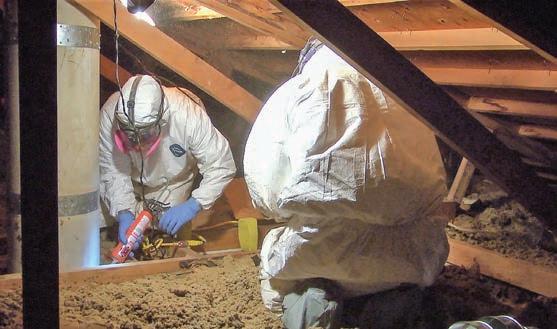

Air sealing prevents drafts and air in ltration from the outside of your home. Consider air sealing before adding more insulation to areas of your home, such as the attic. Photo courtesy of Project Home
There are di erent types of insulation, including berglass batts, blown berglass, cellulose, and foam. Each has its own R-value, which is listed on the packaging.
Recommend R-values range from R-30 to R-60. Here in Wisconsin, R-49 to R-60 is recommended in an uninsulated attic, and R-38 to R-49 is recommended if there is existing insulation. Use R-25 to R-30 for the floor. If you use your attic for storage, you can build a raised platform with room for insulation underneath. Add insulation and weatherstripping to access doors or hatches.

Q: What cost-e ective improvements will make my home comfortable year-round?
Exterior walls and walls separating heated and unheated areas of the home—such as garages or enclosed porches—should be insulated to an R-value ranging from R-13 to R-21, based on your location and wall construction.

Wall insulation can be installed during construction or a remodel. If your home wasn’t insulated when it was built, you can have the insulation blown in by a contractor. Blown-in options include cellulose, fiberglass, and foam.
Your home should also be insulated between the floor and crawlspace or unheated basement. If your basement is heated, install insulation in the box sills—the area between the foundation floor of the home’s main level.
Consider building and insulating the exterior walls in the basement or installing foam insulation on foundation walls. Check your local building code requirements.
Recommended R-values for floor insulation range from R-13 to R-30. Also insulate heating and cooling ductwork located in unconditioned spaces to prevent energy waste.
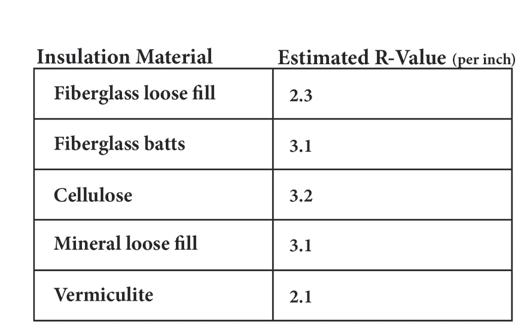
Think of insula tion as a cozy sweater and air sealing as a windbreaker for your home.
You know that cozy sweater is no match for winter winds, so you need an extra layer to stop it from ripping through. The same goes for your home.
Air sealing pre vents drafts and air infiltration from out side. It can improve efficiency, comfort, and indoor air quality.
Air sealing can
be done as a DIY project, but it is challenging to pinpoint and proper ly seal air leaks. Consider hiring a contractor to complete a blower door test and seal leaks.
Typically, air sealing is done around plumbing and electrical penetrations with spray foam or caulk. If using spray foam around gas appliances, temporarily turn off pilot lights. Spray foam is extremely flammable.
Sheet metal and high-temperature heat-resistant caulk should be used to seal gaps between framing, chim neys, and metal flues.
If you are considering a DIY approach, protect yourself when going into spaces with insu lation. Wear a prop erly fitted mask or respirator. Wearing a Tyvek suit and gloves also is recommended. Kneepads can come in handy and make the crawling more bearable.
If you are planning a DIY approach for air sealing, do your research about best practices for the proper home ven tilation. Before going the DIY route, contact two or three local contractors for a project estimate. Sometimes the contractor can get cheaper bulk pricing on insulation.
Making insulation and air sealing a priority adds comfort, efficiency, and savings to your home.
Miranda Boutelle writes on energy efficiency topics for the National Rural Electric Cooperative Association, the national association representing more than 900 local electric cooperatives.
Anarticle in the March issue of the Wisconsin Energy Cooperative News, “Powering Through the Potential Perfect Storm,” looked at how supply-chain woes affected Wisconsin’s electric cooperatives earlier this year. Seven months later, with forecasts complete for 2023, not much has changed.

The supply-chain crisis has contributed to high inflation, disrupted almost all industries, and wreaked havoc on the U.S. economy with no end in sight. However, electric cooperatives continue to weather the blows through careful planning and creative problem-solving.
Enter RESCO (Rural Electric Supply Cooperative), a not-for-profit cooperative headquartered in Middleton, that sells utility distribution materials and supplies to rural electric cooperatives. Created in 1936, RESCO supplies 260 members with distribution and transmission materials across nine states. It functions as a cooperative owned by the electric distribution cooperatives that purchase from it and has worked doubly hard the past few years to keep co-ops supplied with what they need to keep rural Wisconsin’s lights on.
“Obviously, we deal with other vendors, and not to knock anybody, but RESCO is definitely there for us,” said Danny Jordan, warehouse manager at Rock Energy Cooperative, headquartered in Janesville. “It’s a little different because RESCO’s a co-op, I feel. They want to help.”
Jordan recalled a specific job for new construction on co-op lines for an Amazon distribution center in Beloit. RESCO scrambled to get a larger transformer than it typically carries in Wisconsin from one of its warehouses in Tennessee. With little notice, RESCO came through for the co-op, helping the project to remain on schedule.
2021 and 2022 as one of the biggest headaches faced by the industry but has seen utility product inflation starting to level off a bit. In 2021, RESCO saw a 14% average cost inflation rate on all products it sells. Just the first five months of 2022 brought a 9% average cost inflation on products, with a forecasted inflation rate of 15–20% for the full year. So, in only 17 months, utility material costs increased by 23%.
To say that increase is a burden on cooperative budgets is an understatement.
Brandrup cites four main drivers behind the product price inflation: commodity price increases, wage inflation, freight and shipping cost increases, and a general supplyand-demand imbalance.
Big parts of the supply/demand imbalance are demand drivers like an increase in new housing construction and larger home loads tied to EV charging needs, and grid modernization projects linked to renewables coming on-
line. Add to those other industries competing for the same input materials, and the squeeze tightens. For example, new meters need the same computer chips other sectors like automotive production rely on, not to mention that industry’s need for steel.
Matt Brandrup, RESCO president and CEO, confirms that he sees supply-chain issues continuing well into 2023 and likely 2024.
Brandrup cites significant product price inflation in
“You kind of get a perfect storm of demand growth,” said Brandrup. “Obviously, the economy is strong. Associated with that strong economy—housing has really come back. With that comes demand for supplies
Members- rst approach illustrates the cooperative way through supply-chain crisis
“I’ve always said this. Co-ops have done such a great job of vertically integrating their businesses for the bene t of their members...”
Matt Brandrup, RESCO president and CEO
to provide that new construction with power.”
But according to Brandrup, commercial growth is also increasing demand. “So, demand is very strong with single-phase transformers, which serve residential homes, but there is also incredible demand for three-phase transformers, which are the very large transformers that serve the local gas station or other large commercial or industrial facility, for example,” said Brandrup.
Aside from the significant increase in the cost of supplies needed to keep the energy flowing, the timeframe to get supplies in hand has also drastically increased.
As reported in March, the need for transformers is at record highs.
“Transformers are the biggest issue right now. You can’t put a new or upgraded residential or commercial service in place unless you have a transformer,” said Brandrup.
Typical lead times before 2020 were 10–12 weeks, which was the case for many years. Today, cooperatives can expect lead times of 1–2 years for the same transformers. Similarly, lead time for conductor typically averaged 8–10 weeks. It now stands at 40–50 weeks.
“We used to go week by week with a lot of things before. Now we’re thinking, ‘What are we doing next year?’” said Jordan of managing in ventory at his co-op. “I know RESCO has upped their inventory. We have as well because we don’t know what tomorrow’s going to bring.”
The long lead time is not for lack of effort. Brandrup reports that all manufacturers have full plants and still can’t keep up with demand. He also notes that the utility industry, in gen eral, is supplied mainly with products manufactured domestically.
According to Brandrup, though, there is a bright spot in 2023 due part ly to the cooperative business model. RESCO will receive a significant increase in production allocation from ERMCO, another cooperative that manufactures transformers. ERMCO is allocating the vast majority
of its 2023 production resources to its cooperative partner distributors, like RESCO.
RESCO stands to see a 35% increase in its 2023 single-phase allotment from ERMCO and a 65% increase in three-phase production allotment. “It’s going to help us, but it’s not going to take care of the issues that are out there,” said Brandrup.
To do this, ERMCO is stepping back from much of its investorowned utility business opportu nities and instead making sure they supply the nation’s electric cooperatives first. Owned and controlled by 17 Arkansas electric cooperatives, ERMCO works with eight other cooperative-owned distributors like RESCO.
“I’ve always said this. Co-ops have done such a great job of ver tically integrating their businesses for the benefit of their members, and this is just another example of that. ERMCO was created by the co-ops to manufacture and sell transformers to RESCO. RESCO then sells those transformers, on a not-for-profit basis, to our mem ber co-ops to provide reliable and very cost-effective service to their members. That is the co-op way, and it works very well, especial ly when there are challenges in the marketplace like we see today,” said Brandrup.
Therein lies the cooperative dif ference. ERMCO, acting as a coop erative, has consistently offered the most attractive product prices despite the opportunity to charge significantly more. Its long-term strategy is to take care of the electric cooperative family first.
RESCO is run much the same. Through the cooperative model, it passes back any excess margins to the members. Both entities charge enough to cover the costs, not to take advan tage of the current supply/demand disparity.
“We have investor-owned utilities coming to us asking, ‘How many transformers can you sell us?’” said
Brandrup. “RESCO is taking the members-first approach when it comes to materials. Yes, we’d love to help out all utilities, whether they’re a municipal, co-op, or IOU, but for us, being member-owned, we’ve taken the
In the last 20 years, Wisconsin’s electric cooperatives have purchased almost $450,000,000 in materials from RESCO. RESCO has returned more than $15,400,000 in patronage refund dollars to them.
RESCO is able to offer extremely competitive pricing on the material they sell to the co-ops due to their not-for-profit cooperative model, and RESCO passes back patronage refund dollars to the co-ops (if they do make any extra margins during the year).
Co-ops get needed utility supplies/ material at the lowest cost possible. If RESCO were not around, material/ supplies would need to be purchased from a for-profit supply entity at higher prices.
The savings co-ops realize by purchasing from RESCO is passed on to members by keeping rates as low as possible.
‘members first’ approach in ensuring we have enough inventory for our members.”
That being said, there are some exceptions.
“All nine of the cooperative utility distributors around the country share inventory in times of need,” said Brandrup. “So, whether it be a large ice storm, tornado, or a hurricane, to the extent any of us can help and share inventory, we do that in an effort to take care of the co-op community as a whole.”
The fact remains that supply will continue to be tight and expensive heading into 2023.
Members First RESCO plans to continue to put members first, starting with carrying record inventory
levels. Currently, RESCO has about $42 million in inventory, double the figure from a couple of years ago. And Brandrup stresses communication, communication, communication.
First, as a supplier, RESCO constantly communicates in ventories to its distribution cooperative members. Second, dis tribution cooperatives are encouraged to communicate current realities with members and developers so no one is caught off guard by long lead times. Third, Brandrup values the commu nication he has with his suppliers, like ERMCO.
Another bright spot is RESCO’s planned 40,000-squarefoot warehouse in Stanley, scheduled for completion in early 2024. Currently, most supplies for Wisconsin’s electric cooper atives come from their Middleton warehouse. Once complete, the Stanley location will allow RESCO to hold more inventory at a more geographically central location among Wisconsin’s electric distribution co-ops.
“That will put us halfway between there and Middleton,” said Matt Riggs, project supervisor at Oakdale Electric Cooperative. Riggs has worked at the co-op for 26 years and currently manages the warehouse. “But having another warehouse, it’s going to be advantageous to us because we’ll have two warehouses close.”
Other ways Wisconsin’s electric cooperatives have adapted and maneuvered to keep projects on schedule and power flow ing are twofold. One is a more diverse brand acceptance. The second is a new trend to carry more material inventory.


“Basically, all of our 2023 transformer orders are in, and we have allocated much of our entire allotment of transform ers to our members for 2023 already,” said Brandrup. When asked what that planning looked like before 2020, Brandrup replied, “When lead times were normal, we would receive a member’s order and ship transformers eight to 10 weeks later. So now we have to plan out most of our 2023 transformer shipments to our members six to 12 months ahead of time.”
Communication Again, communication between members and co-op is critical.
“I don’t know if our members or new members realize that if they may want to build a house, we may not get a trans
former for up to a year sometimes,” said Danny Jordan. But he also remains proactive. “I try to stay pretty involved with [the operations department]; it helps me know when stuff is coming up. I’m not waiting for operations to tell me we have a new subdivision. I’m asking, ‘When’s the next big project? What projects are we looking at for next year?’”
His advice? Contact your co-op as soon as you are consid ering construction to get in the co-op’s work plan.
Local electric co-ops have had to expand and reorganize their warehouses to accommodate the increased inventory they now need to keep on hand, which has some questioning if they are hoarding inventory.

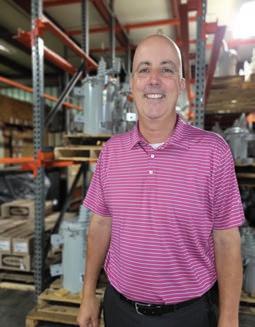
“Yes, they’re carrying a lot more inventory material. But they have to because lead times have gone out so far. If you’re planning a utility project for six months out or 12 months out, you need to order and bring that material in much further ahead of time than you did before,” said Brandrup.
“We used to keep a minimum amount of supplies on our shelves because you’d send out an order for material, and you’d have it in a week or two,” said Riggs. “No matter what you had on the order, it seemed like it was just available. We never concentrated on having a lot on the shelf because it was just available. Nowadays, just forget it. A lot of stuff is a year out, or they don’t know when you’ll get it.”
Riggs reports that the demand for new services at Oakdale never slowed down due to the pandemic, and they keep the warehouse stocked to keep lineworkers on three construction crews busy and on schedule. When asked to compare what the warehouse looked like a few years ago to its current state, he said, “If anything, now, I’d say it’s more cluttered. Be cause before, you never had boxes of stuff sitting on the shelf. Where now you might have three extra boxes of something just because you better get it while you can get it.”
“I would call it being prepared,” said Riggs. Riggs’ message to co-op members?
“Be patient and understanding,” said Riggs. “If we’re not able to get it done immediately, it’s probably all because of the supply chain.”
—Dana KelroyWe are here to celebrate you! Returning capital credit retirements to our members is one way we like to celebrate. This year, Eau Claire Energy Cooperative will return over $861,000 to more than 15,400 members. In fact, ECEC has returned over $20 million to our members since our inception in 1938. Capital credits are a unique bene t of your cooperative membership. Keep an eye out on your October bill for your bill credit!
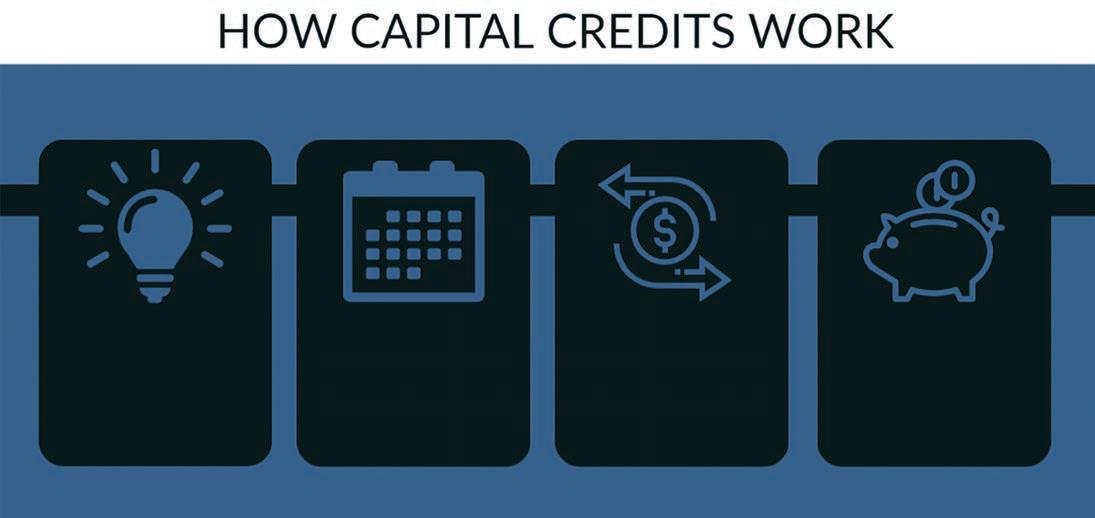
As you pay your monthly electric bills, Eau Claire Energy Cooperative uses the income to grow, operate, and maintain a safe and reliable electrical system. Any money received over and above the cost of doing business is called margins. Your portion of the margins is then returned to you in the form of credits. In co-op utilities the profits are returned to you, the member. In other types of utilities, the profits go to a select group called stockholders.
How will I get my capital credit retirement?
Credits accumulate in an account in your name. When the board of directors approves a retirement of capital credits each year, they are approving the return of a specific percentage to be distributed to you. Capital credits are then issued to qualifying members as a
bill credit on their October bill. It can be seen in the upper right-hand corner on your billing on your October bill. This year, those bills will be sent out on October 7, 2022.
What happens if I move o ECEC lines?
If you move from one ECEC address to another, your capital credits will follow you. If you move from an ECEC address to a nonECEC address, you will no longer accumulate new capital credits, but you will still receive any allocated credits from the time you did live on Eau Claire Energy Cooperative lines. Please be sure to update your address with us to ensure you continue to receive your retirement. You can update your address on your SmartHub account, on our website, or you may call our office.
Members use electricity provided by Eau Claire Energy Cooperative. Then ECEC tracks member usage and payments.
Year-end accounting and audit are completed. Financial obligations to the cooperative are met.
Board approves the portion of the margins to be distributed to members as credits.
Capital credits are applied to bill.
ACE Hardware, State Farm, REI, Land O’Lakes, and Eau Claire Energy Cooperative all share something in common: we’re all cooperatives. We may be in di erent industries, but we all share a passion for serving our members and helping our communities to thrive. In fact, all cooperatives adhere to the same set of seven principles that re ect our core values of honesty, transparency, equity, inclusiveness, and service to the greater community good. October is National Co-op Month, so this is the perfect time to re ect on these principles that have stood the test of time but also provide a framework for the future. Let’s talk about the seven cooperative principles. Voluntary and Open Membership
Just like all co-ops, ECEC was created out of necessity––to meet a need that would have been otherwise unmet in our community. So, in 1938, a group of neighbors banded together and organized our electric co-op so everyone in our community could benefit. Today, key parts of that heritage remain––the focus on our mission and serving the greater good. In this, we include everyone to improve the quality of life and economic opportunity for the entire community. Membership is open to everyone in our service territory, regardless of race, religion, age, disability, gender identity, language, political perspective, or socioeconomic status.
Our co-op is well suited to meet the needs of our members because we are locally governed. Each member gets a voice and a vote in how the co-op is run, and each voice and vote are equal. Eau Claire Energy Cooperative’s leadership team and employees live right here in the community. Our board of directors, who helps set long-term priorities for the co-op, also live locally on co-op lines. These board members have been elected by neighbors just like you. We know our members have a valuable perspective, and that’s why we are continually seeking your input and encourage you to weigh in on important co-op issues and participate in co-op elections.
Our close connection to this community ensures we get a first-hand perspective on members’ priorities, thereby enabling us to make more informed decisions on long-term investments, such as member solar programs, equipment and technology upgrades, and our SmartCHARGE electric vehicle program.

As a utility, our mission is to provide safe, reliable, and affordable energy to our members. But as a co-op, we are also motivated by service to the community, rather than profits. Members contribute equitably to, and democratically control, ECEC’s capital. At least part of that capital remains the common property of the cooperative. Members allocate surpluses for co-op programs, initiatives, capital investments and supporting other activities approved by the membership.
The fourth principal, Autonomy and Independence, means that the coop operates in an autonomous way that is solely directed and guided by its members, reflecting the values and needs of our local community. This means the co-op is not being influenced by leaders or shareholders several states away. Instead, the co-op is led by the local members it serves.
Education and Training focuses on enhancing the knowledge of co-op employees and board members, which enables them to contribute to the development of the co-op. By investing in continuous learning for our employees and board members, our co-op is making a commitment not just to individual professional and personal growth, but to the future of the co-op and the high quality of service our members expect and deserve. It’s a win-win situation.
We also strive to inform our members (that’s you!) and the public

about the mission and operations of the co-op. In fact, that’s why you receive this magazine every month, so we can share the latest co-op news and updates, as well as energy efficiency and safety tips.
Cooperation among cooperatives fosters the way that co-ops work together to address bigger challenges. While this principle applies to all types of cooperatives, it is especially relevant in the energy industry. In our case, we put this principle in action after major storms and disasters that cause widespread power outages. When this happens, we call on nearby co-ops to come to our aid and assist with restoration efforts––and we of course extend the same help to them when they need us. We can’t think of a better example of cooperation among cooperatives.
In addition, because we are part of the national electric co-op network, we can connect and collaborate with other electric co-ops to tackle industry-related challenges, like
cybersecurity and an everchanging energy landscape.
Concern for Community is essential to who we are as cooperatives. We serve our community not only by being an essential service, but by helping to power our local economy. Whether through economic development, volunteerism, or donations to local causes, we invest in this community because it’s our home too.
Because we are guided by seven cooperative principles, it’s not just about dollars––it’s about opportunity for all and being fair when engaging with our members. The cooperative way is a values-based business model.
ECEC is a reflection of our local community and its evolving needs. We view our role as a catalyst for good and making our corner of the world a better place.
You will find that most cooperatives bring good people together to make good things happen in the community.
On behalf of everyone at Eau Claire Energy Cooperative, we’re thankful for your membership.
• Always hover over a link first to be sure it is safe.
Report suspicious emails or emails from an unknown sender to your spam filter and delete them from your inbox.
• Create long and unique passwords. Use familiar phrases or song lyrics you’ll remember.
• When possible, use 2-factor authentication as a second layer of defense.
• Change passwords regularly, and do not share them.
• Phishing attempts seek to steal or compromise data and will often mimic a known sender.
Look for red flags:
1. the email is unexpected;
there is a sense of urgency conveyed;
there is an o er that seems too good to be true; and/or
there are typos and misspellings.
• The best defense against viruses, malware and other online threats is keeping your equipment up to date.
• Work with your IT staff (or provider) to keep your software, including your web browser, and operating systems current.

• Use encryption to protect sensitive data.
• Limit the spread of any attack by only accessing files and folders you need.
• Do not put confidential information in emails, or instant and text messages.
• Treat all public Wi-Fi networks as a security risk, and don’t make financial or other sensitive transactions over public networks.
more tips to improve your cyber hygiene?


















































Recipe and photo courtesy of the Iowa Pork Producers Association.



1 ( 6 or 7 oz) Long Grain and Wild Rice Box Mix (dry mix plus seasoning packet)
1 (10.5 oz) can condensed cream of mushroom soup

1 (10.5 oz) can condensed cream of celery soup

2 cups chicken broth
4 scallions, chopped, divided
4 Tbsp minced fresh parsley, divided
4 (8 oz) boneless center cut pork loin chops
1/2 tsp seasoned salt
1/4 tsp ground black pepper
1 cup shredded Monterey Jack cheese


Preheat oven to 350 degrees. In a medium mixing bowl, add dry rice plus seasoning packet, cream of mushroom soup, and cream of celery soup. Whisk until combined. Pour rice mixture into a greased 9-×13inch glass baking dish. Cover dish tightly with aluminum foil and bake for 60 minutes. Remove baking dish from oven, uncover. Stir half of the chopped scallions and half of the minced parsley into rice mixture, reserving remaining scallions and parsley for garnish.
Place pork chops over rice mixture in the pan. Sprinkle on seasoned salt and ground pepper; top with cheese. Return to oven, uncovered, for 15–20 minutes until cheese is melted and golden and pork chops register 145 degrees on an instant read thermometer.* Remove casserole from oven and sprinkle chopped scallions and minced parsley over top. Serve warm.
Pulled Pork Soft Tacos

Recipe and photo courtesy of Midwest Dairy.
Let your slow cooker do the work and come home to assemble dinner in no time. Change up the recipe with di erent shred ded cheeses and vegetable toppings for a one-dish meal to satisfy every taste bud in your family.
Pulled Pork
2 lbs boneless pork loin roast
2 Tbsp brown sugar
1 Tbsp ground ginger
2 cloves garlic, smashed
1 small white onion, coarsely chopped
1/2 cup orange juice
2 limes, cut in half
Trim excess fat off roast. In a small bowl, combine brown sugar and ginger; rub generously over roast. Place in slow cooker with garlic, onion, and orange juice; cook on LOW for 8 hours (or HIGH for 4–6 hours). Remove pork from slow cooker, transfer to large bowl and shred with forks. Strain pork liquid from slow cooker and pour over pulled pork to moisten. Squeeze lime juice on top and mix well. Divide into 12 servings.
Tacos
1/2 cup non-fat sour cream
1 tsp cumin
2 scallions trimmed and chopped
12 (6-inch) round, soft corn tortillas
1-1/2 cups shredded, reduced-fat Colby Jack cheese
8 oz shredded red cabbage (approx. 1 bag)
3/4 cup fresh salsa
In a small bowl, mix sour cream, cumin, and scallions. For each serving, cover corn tortilla with 2 tablespoons cheese; microwave for 20 seconds. Top with pulled pork, 2 teaspoons of sour cream mix, 1-1/2 tablespoons shredded cabbage, and 1 tablespoon salsa. Fold and serve immediately.

Recipe and photo courtesy of the Iowa Pork Producers Association.
1 rack baby back ribs
Barbecue rub
1 cup vegetable broth
1 lb bacon
1 cup barbecue sauce
Remove the thin membrane covering the back of ribs, if still attached. Season ribs with your favorite all-purpose barbe cue rub. Place trivet in Instant Pot, add vegetable broth and seasoned ribs. Close lid with pressure vent closed, set to Meat/Stew. Let cook 25 minutes and the use the quick release method. Open lid, remove ribs, and cut into individual pieces. Wrap one piece of bacon around each rib, securing each with a toothpick. Place on a greased foil tray on a medium-high heat grill. Grill for 15 minutes, turning the ribs every 5 minutes. Brush with barbeque sauce and cook an additional 5–10 min utes. Remove toothpicks and enjoy!

Recipe and photo courtesy of the Iowa Pork Producers Association.
6 wooden skewers
1 lb ground pork
1/2 cup breadcrumbs
1 egg, beaten
1/4 cup finely chopped pineapple
3/4 cup barbeque sauce, divided
1/4 tsp black pepper
1/4 tsp onion powder
Soak skewers in water for at least 30 minutes. Preheat oven to 400 degrees and line a baking sheet with parchment paper.
Combine ground pork, breadcrumbs, egg, pineapple, 1/4 cup barbeque sauce, black pepper, and onion powder in a large bowl. Scoop and roll into balls, about 1-inch in diameter and carefully thread 4 meatballs onto each skewer. Place the kabobs on the parchment-lined baking sheet. Bake for 10 minutes, then brush with the remaining barbeque sauce. Flip the kabobs and brush the other side. Bake an additional 8–10 minutes or until the cen ter of the meatballs are at least 160 degrees. Makes 6 servings.
RECIPE COURTESY OF JUDY STONEY, CLINTON
2 (10.5 oz) cans cream of mushroom soup
1 cup milk
2 cups frozen peas
2 (10 oz) cans tuna, drained
4 cups egg noodles, cooked and drained
2 Tbsp dry breadcrumbs
1 Tbsp butter, melted
Stir soup, milk, peas, tuna, and noodles in a 3-quart casserole dish. Bake at 400 degrees for 30 minutes or until hot; stir. Mix breadcrumbs with butter and sprinkle over casserole. Bake 5 additional minutes or until breadcrumbs are browned. Serves 8.
RECIPE COURTESY OF PEGGY HOYER, ELLSWORTH
HERE IS THE RECIPE I USE FOR LARGE GROUPS; IT’S EASY TO MULTIPLY TO MAKE LARGE AMOUNTS.
An online reader is looking for readers’ favorite recipes using Brussels sprouts.
SEND TO: WECN, Reader Recipes, 222 West Washington Ave., Suite 680, Madison, WI 53703-2719 or jennifer@weca.coop.
Submit your
recipes to be featured on our reader recipe page. Email to jennifer@weca.coop or submit directly at http://wecnmagazine.com/submit-a-recipe/. Due to food safety issues, we cannot accept canning recipes.
2 lbs boneless pork loin, cut into cubes
Wood skewers
1/2 cup our
1/2 tsp garlic powder
1/4 tsp pepper
1/4 cup butter
3 Tbsp vegetable oil
1 (2 oz) pkg onion soup mix
14-1/2 oz chicken broth
1 cup water
1 Tbsp cornstarch
1 Tbsp cold water
4 lbs ground beef
2 large onions, minced
1 Tbsp salt
1 tsp pepper
1/3 cup our
1 qt water or stale beer
1 Tbsp Worcestershire sauce
3 cups ketchup
1–2 Tbsp chili powder
30–32 large buns
Brown beef with onions, stir until crumbly. Put meat and onions in a Dutch oven and add salt and pepper. Stir our into the mixture. Add water or beer, Worcestershire sauce, ketchup, and chili powder. Simmer for 20 minutes. Stir occasionally. Serve on buns.
8 oz wide noodles, cooked
3 cups diced chicken
1/2 lb fresh mushrooms, sliced and sautéed in butter
1/4 tsp sage
1/2 tsp salt 1/2 tsp pepper
2 (10.5 oz) cans cream of celery soup
1 cup sour cream
8 oz mild shredded cheddar cheese
Mix cooked noodles with all ingredients except cheese. Place in a greased, 2-quart casserole dish; top with cheese. Bake at 350 degrees for 30 minutes. Serves 10–12.
Thread pork cubes (approx. 5) on small wooden skewers (cut to t skillet). Combine our, garlic powder, and pepper. Roll kabobs in our mixture to coat. In a large skillet, heat butter and oil. Add kebabs; cook until browned, turning frequently. Remove from heat; drain. Sprinkle soup mix over pork, add broth, and one cup of water to skillet. Boil, reduce heat, cover, and simmer for 15–20 minutes until pork is tender. Remove kebabs from skillet. Whisk cornstarch and 1 tablespoon cold water together and add to pan juices. Cook until smooth. Serve with mashed potatoes or vegetables.
RECIPE COURTESY OF LAVAUGHN BUEHL, JANESVILLE
1 tsp plus 3/4 cup butter, cubed
45 Club crackers (butter crackers)
1 (14 oz) can sweetened condensed milk
1/2 cup brown sugar
3 Tbsp light corn syrup
1 cup semi-sweet chocolate chips
Line a 9-inch square pan with foil. Grease foil with 1 tsp butter. Arrange single layer of crackers in bottom of pan. In a saucepan, combine sweetened condensed milk, brown sugar, corn syrup, and remaining butter. Bring to boil over medium heat, stirring occasionally. Reduce heat to maintain a low boil for about 7 minutes, stirring occasionally. Remove from heat and evenly spread 1/3 of the mixture over crackers in pan. Repeat the cracker and caramel layers twice. Immediately sprinkle chocolate chips over the top, allowing to melt approximately 3–5 minutes or until glossy. Spread chocolate over the top. Cover and refrigerate for 2 hours or until chocolate has set. Lift out of pan using foil and cut into bars.

never a bad time to visit Northwest Wisconsin, but an autumn trip to this part of the state is especially appealing. October serves up a visual feast in this region, with the woods and forests bursting into bright hues of crimson and gold and the many lakes and waterways a crisp, shimmering blue.
The visual allure, however, is not limited to the outdoors. You’ll find plenty of color and beauty indoors as well at the Wisconsin Regional Art Program (WRAP) art exhibit, held at the Heyde Center for the Arts in Chippewa Falls October 13 through November 18. Co-hosted by the Valley Art Association (VAA), the exhibit features art in a wide variety of media created by local, nonprofessional artists.
WRAP exhibits are held throughout the state, with a focus on promoting the arts in rural areas. This VAAsponsored exhibit is especially unique in that it’s the first one to be held in the Chippewa Valley. It’s an opportunity for participating artists to gain some exposure, but also

for the public to see the artistic talent that thrives in the countryside, where the wildlife and natural landscapes provide endless inspiration.
“There’s a tremendous amount of artists in the rural areas,” said Val Naber, coordinator of Chippewa Valley WRAP, VAA executive officer, and member of Dunn Energy Cooperative. Naber is an artist herself, specializing in painting on porcelain. “We have beautiful weavers and basketmaking people and porcelain painters. There’s plenty of acrylic and watercolor painters, and we have some beautiful photographers who take some fantastic pictures of the rural areas,” she added.
VAA has about 130 active members from counties within the Chippewa Valley, as far north as Barron and Rusk counties, and also from a little farther south including Trempealeau and Jackson counties.
“They gather monthly to share ideas and maybe help each other through design issues, and VAA itself organizes places for nonprofessional artists to exhibit and
sell their work,” Naber explained.
The WRAP exhibit is one such opportunity. The month-long exhibit is free to the public and culminates with two special events that are also open to the public: judging and a workshop on November 3, and an artist reception on November 5, complete with live music provided by area high school performers, refreshments, a silent auction, and an opportunity to mingle with the artists. Awards will also be presented at this time.
The Chippewa Valley WRAP exhibit, Naber explained, is a perfect vehicle for executing VAA’s mission of engaging the public with local
art, whether by participating in art or simply viewing it.
WRAP is a program administered by the Association of Wisconsin Artists (AWA), a Madison-based organization that promotes art in Wisconsin. Entities including but not limited to local art organizations such as VAA are encouraged to partner with AWA in hosting a WRAP exhibit in their area. Participating artists must be nonprofessional, meaning they cannot earn the bulk of their income through their artwork.
The exhibits are judged by a professional artist, who selects pieces that will advance to AWA’s statewide competition held in August each year.
Judging the artwork at the Chippewa
Falls WRAP exhibit will be Amanda Bulger, art lecturer and director of the Foster Art Gallery at UW-Eau Claire. Winning artwork will be eligible for the state exhibit in 2023.
Each WRAP exhibit must have an educational component to it as well, with a workshop or demonstration by a professional artist. At the VAA WRAP exhibit, Allan Servoss, who specializes in water colors, will be on hand November 3 for a presentation called ”How to Achieve Unity in your Art.” The workshop is free for exhibiting artists, but $5 for members of the public.
In addition to the WRAP exhibits, AWA oversees the State Teen Artist Mentoring Program (STAMP), which
From porcelain to painting, textiles to photography, a wide variety of art produced by local rural artists will be on display at the Chippewa Valley WRAP exhibit.
Here’s just a sampling of the kind of art visitors can expect to see.
Member of Dunn Energy Cooperative Specializes in porcelain and watercolor paintings



Mary Hermanson
Member of Riverland Energy Cooperative Specializes in ber and textile art

Member of Eau Claire Energy Cooperative Specializes in photography and fused glass


the VAA is offering in conjunction with the Chippewa Valley WRAP exhibit. For this program, student artists aged 13–19 may enter their own work, which will be judged separately. The student artwork will be on display at the Heyde Center alongside the work of the more established, adult artists. The whole collection will offer a visual feast all its own.
“We really want the public to come and help make them aware that there are a lot of active artists in the area, with some great artwork to see,” Naber said.
It’s just one more reason to drive through the Chippewa Valley in the fall.
—Mary Erickson
The Chippewa Falls WRAP Art Exhibit will be open to the public for viewing from October 13 through November 18 at the Heyde Center for the Arts, 3 S. High Street, Chippewa Falls, WI 54729. The center is open Monday from 10 a.m. to 5 p.m. and Tuesday through Friday from 10 a.m. to 4 p.m., with weekend hours as special events call for. For more information on the WRAP art exhibit, visit wisartists.wildapricot.org.


Holiday time will soon be here, and we don’t just mean Halloween! We’re aware that most readers are likely just setting up their fall décor, but still, Christmas isn’t that far away. The artists of the Valley Art Association o er an easy way to shop local for unique, personal gifts. Visit the organization’s website, valleyartassociation.org, and click on Gallery in the menu to nd biographies of VAA members, including contact information for each and links to examples of their artwork. You’ll nd just about every kind of artwork imaginable here, from paintings to pottery, ceramics to sculptures, wool rugs to wood designs. The website is not a sales vehicle, but visitors to the site may reach out to the artists individually to inquire about purchases.

Heyde Center for the Arts, where the Chippewa Valley WRAP art exhibit will be held, is an exhibit all its own. Placed on the National Register of Historic Places in 1983, the building is the former Chippewa McDonell Memorial High School. Built in 1907 by local lumberman Alexander B. McDonnell in memory of his wife, Mary Regina O’Neil, in the Greek architecture style, the school was state-of-theart in its time, with a top- oor auditorium. It served as a school until 1964, when a new high school was built on the other side of Chippewa Falls. For the next 10 years the building fell into disrepair until the founding members of the Chippewa Valley Cultural Association (CVCA) determined to save the building from demolition. The CVCA renovated the building and transformed it into a venue for local artists, performers, writers, and other creative producers. Each year, approximately 18,000 people visit the Heyde Center for performances, exhibits, and special events.
The


• Clear dry leaves from any outdoor outlets, light xtures, and power cords. Dry leaves can catch re if hit with a spark of some kind.

• Use only GFCI outlets outdoors. There’s more moisture and rain in the fall than in the summer, so be extra mindful that water and electricity don’t mix.

• Stay clear of power lines when cleaning your gutters. Make sure your ladder is positioned at least 10 feet away from any power lines and their connections.

• Check appliance cords for wear before you use them. Make sure tools like your leaf blower didn’t su er any damage while sitting in storage for the past year.
• Store your summer electrical tools with care. Put them in their proper storage locations instead of leaving them exposed to the elements over the fall and winter, which may degrade them and increase the risk of damage.
Source: SafeElectricity
WANTED: Paying cash for WWII ags, daggers, swords, guns, etc. Also, lever-action ri es. 715-340-1974.
WANTED: DEER TAGS, back tags. Trapping, bear, hunting licenses. Otter, bobcat, sher tags. Old traps. David Schober, W4234 Rock Creek Rd., Loyal, WI 54446. 715-255-9284.

CHAINSAWS WANTED DEAD OR ALIVE. Buying 1 or 100 McCulloch, Pioneer, Jonsereds, Echo, STIHL, Homelite, Remington, Mall. Buying all brands and sizes. Non-running, running, seized, parts. Let me know what you have—will travel. Call Chainsaw Mike at 715-828-9414.

WANTED: RED WING STONEWARE. Crocks, beater jars, bean pots, poultry fountains/feeders with advertising. 608-7672282 email slawag@tds.net.
SEPTIC PROBLEMS: Do you have standing water on your drain eld? Have you been told you need a new expensive septic system? I have an alternative that works, also comes with a warranty (no digging). Call toll free 855-797-6072 or email mmtagm@ yahoo.com.
OLD MOVIES TO DVD—Transferring 8mm, VHS, slides, and all formats. Saving family memories! Special on now! DVD Productions. Gene 715-827-2302.
FOR SALE: VINTAGE WOODEN WHEEL RUNNING GEAR. Excellent condition. Always stored indoors. Also vintage Ford truck box, in excellent condition. Photos on request. Manitowoc County. Phone 920-905-0068.
2 CYLANDER WISCONSIN ENGINE, COMPLETE. Hand crank start. $100. Montgomery Ward 10 HP engine, electric start. $50. 715-372-6540.
STAINLESS STEEL GUTTER GUARDS. Cleaning of gutters included so get it done before the leaves fall. Attractive pricing, twenty-year warranty. For more information, call or text 608-751-5337.
COLLECTOR LOOKING FOR ANTIQUE OR HAND-MADE LARGE TRAPS. For sale: smaller trapping traps. 715-563-6658.
NORTHWOODS SPORTSMAN’S DELIGHT. Four-bedroom home, garage, and outbuildings, with 144+ acres of land; elds, forests to hunt, and half mile of trout stream, all near the Flambeau River, lakes, snowmobile and ATV trails, and public forests. Privacy. Asking 349K. www.birchlandrealty.com or call Jim at 715-492-1135.
Classi ed ads reach more than 152,000 mailboxes. RATES: For non-members of Wisconsin rural electric co-ops: one insertion, $25 minimum (up to 20 words); additional words, $1.25 each. For members of Wisconsin rural electric co-ops: one insertion, $14 minimum (up to 20 words); additional words, $.70 each. Count name, address, and phone number as part of ad. Please include zip code. FOR PROOF OF MEMBERSHIP, please include your address label from your copy of the magazine. FREQUENCY DISCOUNTS: 2% discount for 3 months; 5% for 6 months; 10% for 12 months. DEADLINE: 1st of the month prior to the month in which the ad is to appear. All classi ed ads must be paid in advance. There is no agency discount on classi eds. Make check or money order payable to: WECA. Mail to: WECN—Classi eds, Attn. Jennifer, 222 W. Washington Ave., Ste. 680, Madison, WI 53703. Ph: 608-467-4638. Email jennifer@weca.coop. We reserve the right to refuse ads.





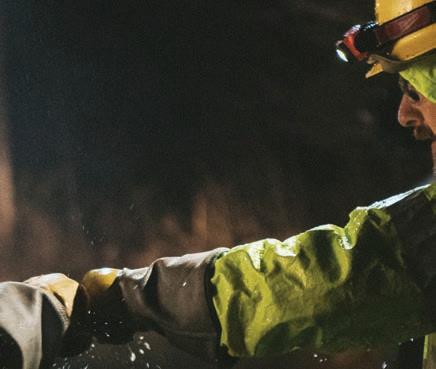












1–31 Harvest Moon Fall Tour—Clark County. Various locations, 8 a.m.–5 p.m. Corn mazes, pumpkin patches, community festivals, and farmers markets. Scoop up home-grown apples, gourds, sweet corn, honey, homemade candy, jams, maple syrup, and more. Experience Clark County’s many artists, meat and cheese shops, boutiques, winery, and many music venues all season long. Greenhouses are loaded with beautiful, bushel-size mums, ornamental grasses, pumpkins, and more 715-255-9100.
1, 6–8 Tours and Burger Nights on the Farm— Mondovi. Together Farms, W93 Norden Rd. Thurs. & Fri. 4–9 p.m. and Sat. 12–9 p.m. Every Thurs.–Sat. through October 8.Burger Nights are unique, casual nights on our small Wisconsin family farm where you can eat in a relaxing atmosphere. Tours on Saturday nights.
1 Apple Affair—Galesville. Fairgrounds (19780 Park Drive), 8 a.m.–4 p.m. Free admission and on-site parking. Over 150 craft vendors, food trucks, quilt show, live music, petting zoo, and kids’ zone. Nationally acclaimed 10-foot apple pie served at noon.
1 Fall Harvest Festival—Phillips. Downtown, 9 a.m.–3 p.m. Arts, crafts, pumpkins, cranberries, music, food, and activities for all ages are featured at this celebration of all things fall.
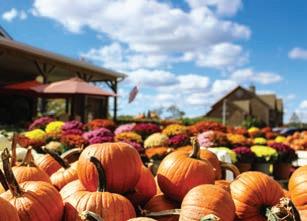
6–8 Book Sale—Onalaska. Library (741 Oak Ave. South), Thurs. 12–6 p.m.; Fri. 9 a.m.–5 p.m.; Sat. 9 a.m.–12 p.m. Sat. bag sale. 608-781-9568.
7–9 Fresh Art Tour—Lake Pepin and Chippewa River Valley areas. 10 a.m.–5 p.m. Enjoy breathtaking autumn views on this self-guided journey to the finest studios and galleries on the Great River Road. Sculpture, jewelry, ceramics, photography, textiles, and paintings.
8 Arts and Crafts sale—Bloomer. Elementary School, 9 a.m.–2 p.m. Over 40 juried exhibitors. Lunch on site. Free-will donation. Vendors contact 612-720-8970.
8 Holiday Bazaar—Eau Claire. Chapel Heights United Methodist Church, 9 a.m.–2 p.m. New crafts, gift baskets, decorations, gifts, the vintage table, the ‘trash to treasures’ room, bake sale, and our famous homemade fruitcakes. Lunch served 10 a.m.–1:30 pm. For more info, call 715-832-2333.
8 ‘All You can Eat’ Spaghetti Dinner—Hayward. Flat Creek Lodge, 4:30–8 p.m. Spaghetti dinner and a night filled with raffles, door prizes, silent and live auctions. Admission: $10 ages 10 and up; $5 ages 2–9; under 2 are free. 715-634-3185.
8 Church Supper—Menomonie. Little Elk Creek Church, 4:30–7 p.m. Bakery table, ham, cheesy potatoes, glazed carrots, cole slaw, apple crisp, and beverage. Admission: $10 adults; $5 ages 6–12; and preschool and under are free.
8, 9 “Artistry in Wood” Woodworkers Show— Denmark. High School, 9:30 a.m.–3 p.m. Largest mixed-media woodworking show in Wisconsin. Admission $5 adults, under 12 free. Classes, competitions, raffle, demos, and food. 920-883-6089.
9 Fall Breakfast—Wittenberg. St Joseph Church-Galloway, 9:30 a.m.–12 p.m. Scrambled eggs, ham and sausage, breakfast casseroles, pancakes, potato pancakes, hash browns, and more! Packers on the big screens. Cash and 50/50 raffles. Admission: $10 adults; $5 ages 6–12; 5 under are free.
9 150th Anniversary Celebration—Boscobel. Hickory Grove Lutheran Church, 10:30 a.m. Worship service, lunch to follow.
9 Glenn Miller Orchestra Concert—Reedsburg. High School CAL Center, 2–4 p.m. This is a rare opportunity to see this iconic ensemble. Group rates available. Tickets are $35 to $25. To reserve, visit the CAL Center Presents website.
8, 9 Falling Leaves Art Studio Tour—Osseo, Fairchild, Augusta, and Fall Creek. Sat. 9 a.m.–5 p.m. and Sun. 10 a.m.–5 p.m. A backroads tour of art studios and stops hidden among the farms and woods. Meet the artists and shop for original art and gifts.
13–31 Wisconsin Regional Arts Show—Chippewa Falls. Heyde Center for the Arts, all day. Creative, non-professional artists sell and exhibit their work for AWA state awards.
15 Craft Masters Craft Sale—Appleton. American Legion Post 38, 9 a.m.–2 p.m. Fall, Christmas, and everyday crafts including jewelry, cards, wooden items, gnomes, soaps, scrubs, metal art, etc. All items are handmade by vendors in the show. Admission $1.
15 Harvest Market—Eau Claire. United Methodist Church, 9 a.m.–12 p.m. Handcrafted woodworking, home decor, crafts, candy, pantry, knit/crochet/sewing, bakery, and card shop. Coffee and rolls starting at 9 a.m. Free admission.
20 Potato Pancake Supper—La Crosse. Trinity United Church of Christ, 4–7 p.m. Tickets available at the door for $12. Supper includes homemade potato pancakes, freshly ground scalloped potatoes, applesauce, cottage cheese, and homemade desserts. Dine in or carry out.
21, 22 QuiltFest on the Mississippi—Onalaska. Omni Center, Fri., 2–7 p.m.; Sat. 10 a.m.–4 p.m. This La Crosse Area Quilters Guild show includes many beautiful quilts on display, and includes vendors, demos, a marketplace, and a raffle quilt.
30 Swedish Meatball Dinner—Greenwood. Our Savior’s Lutheran Church, 11 a.m. Drive-thru only (lower level). All meals are $10 each. Swedish meatballs, mashed potatoes, gravy, copper penny carrots, cole slaw, bun, and dessert.
Wisconsin Events is a public service for our readers. Due to space limits, we may need to eliminate details, so be sure to include a phone number (with area code) where callers may obtain more info. If we receive more listings than space allows us to print, we reserve the right to select those we believe will be of interest to the greatest number of readers. Please no virtual events. Events can also be mailed to: WECN, Events, 222 W. Washington Ave. Ste. 680, Madison WI 53703-2719
1st of the month prior to the month in which the event is to appear.
Send
be
also be
to and owns
1. Finn loves his ock, especially Little Tweet. Photo submitted by Lisa Lukes, a member of Price Electric.

2. Lydia loves when Chief comes to visit. Photo submitted by Janice Hep er, a member of Eau Claire Energy.
3. Legend reads to grandma’s dog, Ivy. Photo submitted by Grandma Shari Hebert, a member of Clark Electric.

4. Danielle and Zoe are a wagonful of cute, with Izzy Belle on lookout. Photo submitted by Grandma Debra Tokheim, a member of Pierce Pepin Cooperative Services.


image, and
the parent or legal
Use only GFCI outlets when decorating outdoors. Use a portable GFCI if your outdoor outlets don’t have them. Don’t run electrical cords across sidewalks or other walkway areas. Fasten outdoor lights securely to trees or other rm supports to protect them from wind damage, but don’t staple or nail through light strings or electrical cords.

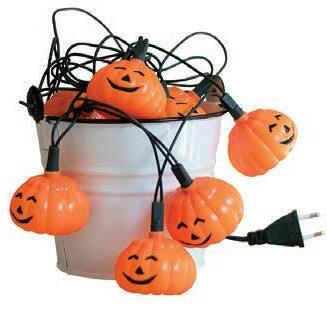
Source: Safeelectricity.org
